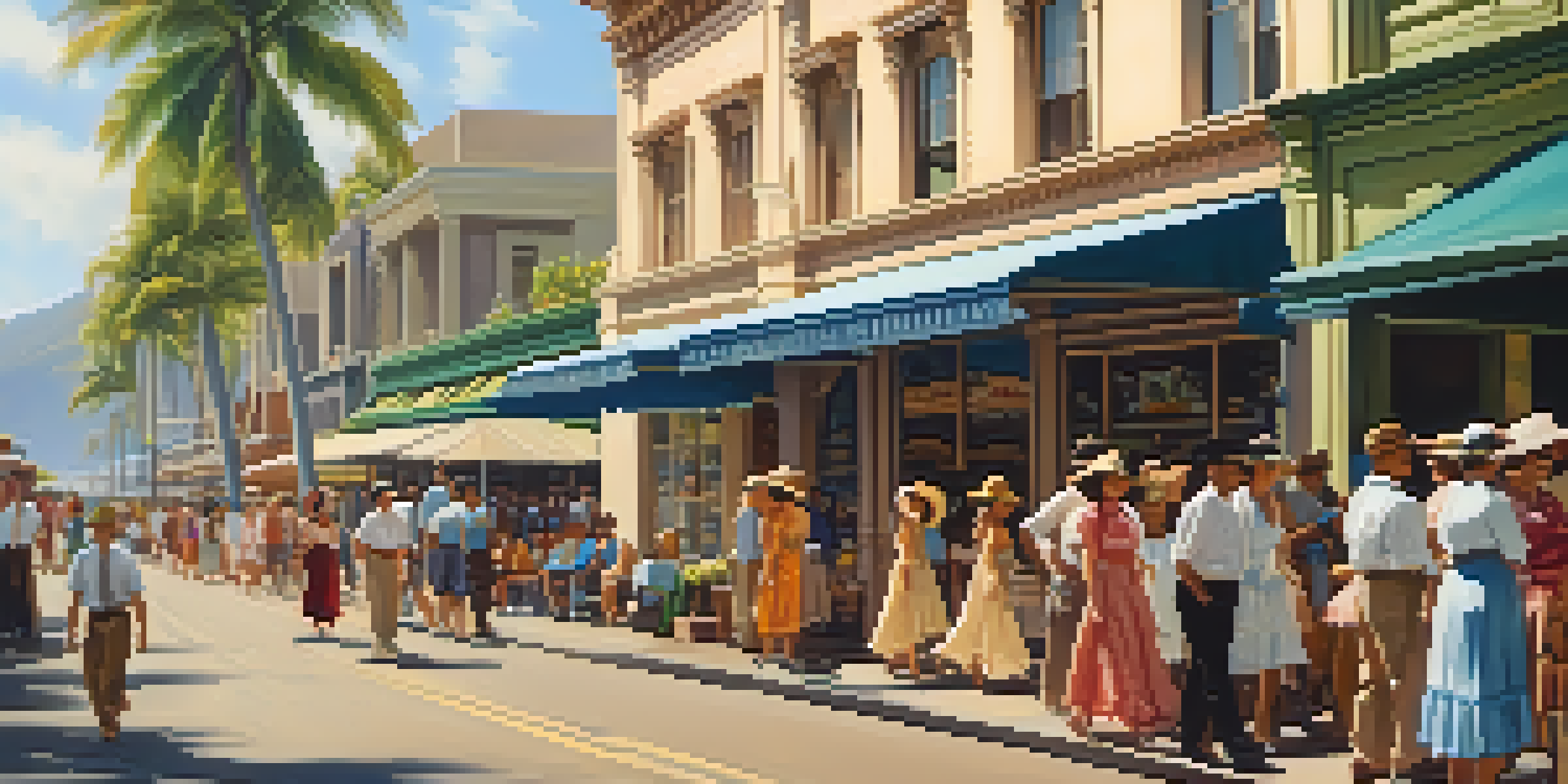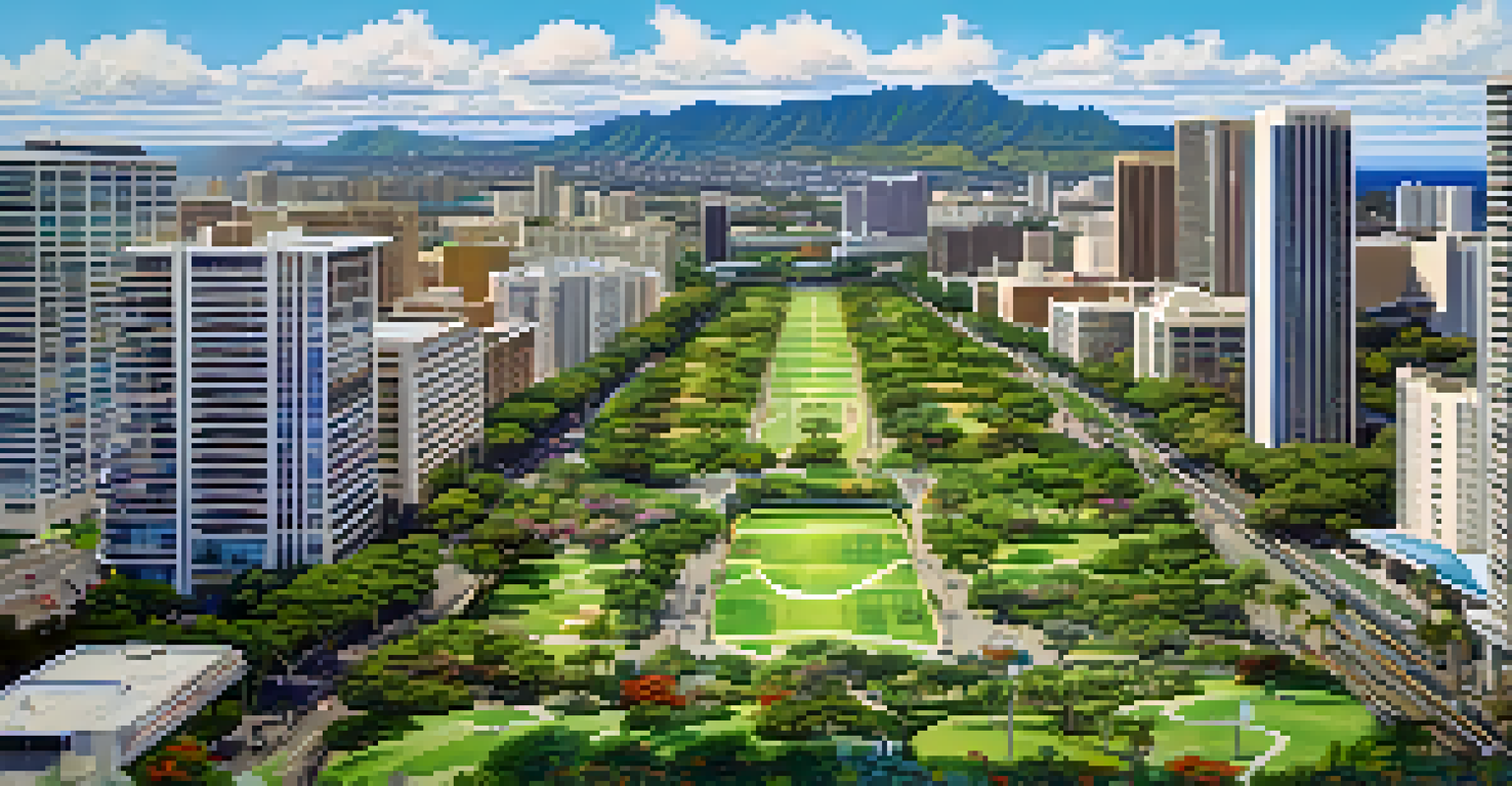Urban Development in Honolulu: 20th Century Changes

The Early 20th Century: Foundations of Urban Growth
In the early 1900s, Honolulu began to transform from a small port town into a bustling urban center. The influx of immigrants and the booming sugar industry played a crucial role in this evolution. As people from various cultures settled in the area, they brought diverse traditions, contributing to the unique Hawaiian identity we see today.
The city is a living organism. It must be allowed to grow, to change, to adapt to the needs of its inhabitants.
Infrastructure improvements, such as better roads and public transportation, were essential in accommodating the growing population. These developments not only made it easier for residents to move around but also fostered commerce and tourism. The legacy of these early investments laid the groundwork for future urban expansion.
Moreover, the establishment of key institutions, such as schools and hospitals, helped solidify Honolulu's status as a vital urban hub. This period marked the beginning of a significant shift in the city's landscape, setting the stage for the major changes that would follow in the decades to come.
World War II: Catalyst for Rapid Development
World War II brought unprecedented change to Honolulu, as the city became a strategic military base for the United States. This influx of military personnel and resources accelerated urban development, leading to the construction of new facilities and infrastructure. The war not only transformed the city's economy but also its physical landscape.

As the military expanded its presence, housing became a pressing issue. Temporary barracks and housing projects sprang up to accommodate soldiers and their families, which ultimately contributed to a housing shortage post-war. This challenge prompted city planners to rethink residential development in the years that followed.
Urban Growth in Early 20th Century
Honolulu's transformation into a bustling urban center was driven by immigration, infrastructure improvements, and the establishment of key institutions.
The war's end also ushered in an era of economic growth, with tourism emerging as a vital industry. The influx of visitors required additional hotels, restaurants, and services, further driving urban development. Thus, World War II served as a pivotal moment that reshaped Honolulu's urban fabric in profound ways.
Post-War Boom: Expanding the Urban Landscape
Following the war, Honolulu experienced a population boom, leading to a surge in urban development. The city began expanding beyond its traditional boundaries, with new neighborhoods sprouting up to accommodate the growing demand for housing. This period saw the rise of suburban living, as families sought larger homes and green spaces.
Urban planning is not about making places; it is about making places better.
The construction of the H-1 freeway in the late 1950s significantly changed the city's transportation dynamics. It improved access to various parts of the island, enabling commuters to travel more easily between urban and suburban areas. This project symbolized a shift towards car-centric planning, fundamentally altering how people navigated the city.
However, this rapid expansion also raised concerns about urban sprawl and the preservation of natural landscapes. As more land was developed for housing and commercial use, discussions about sustainability and environmental protection began to take center stage in urban planning discussions.
Cultural Influences: Shaping Honolulu's Urban Identity
Throughout the 20th century, various cultural influences shaped Honolulu's urban identity. The city's diverse population, including Native Hawaiians, Asians, and Europeans, contributed to a rich tapestry of traditions and lifestyles. This melting pot of cultures is reflected in the architecture, cuisine, and festivals that define Honolulu today.
The preservation of historic sites became a crucial focus as urban development progressed. Efforts were made to maintain landmarks that represented the city's cultural heritage, such as Iolani Palace and Aloha Tower. These sites serve as reminders of Honolulu's past amidst the rapid changes happening around them.
Post-War Development and Challenges
The post-World War II boom led to significant urban expansion and a shift towards car-centric planning, raising concerns about urban sprawl and environmental preservation.
Moreover, the incorporation of local art and culture into urban planning initiatives has helped foster a sense of community pride. Public art installations, cultural centers, and community events celebrate the unique identity of Honolulu, ensuring that urban development honors the city's rich heritage.
Environmental Challenges: Balancing Growth and Preservation
As Honolulu continued to grow, environmental challenges emerged that needed addressing. The rapid urbanization led to issues such as traffic congestion, pollution, and the depletion of natural resources. City planners faced the daunting task of balancing development with the preservation of Hawaii's unique ecosystems and landscapes.
Efforts to promote sustainable practices became essential in mitigating the negative impacts of urbanization. Initiatives such as green building standards and public transportation improvements aimed to reduce the city’s carbon footprint. This focus on sustainability reflects a growing awareness of the need to protect the islands for future generations.
Community involvement also played a significant role in addressing environmental challenges. Residents began advocating for better planning practices and sustainable development policies, ensuring that their voices were heard in the decision-making process. This collaborative approach has been vital in shaping a more resilient urban environment.
Modernization: Innovations in Urban Planning
Entering the 21st century, Honolulu embraced modernization and innovation in urban planning. Technological advancements and new design philosophies influenced how the city approached development. Smart city initiatives, which integrate technology into urban infrastructure, began to take shape, enhancing the quality of life for residents.
One significant aspect of this modernization has been the push for mixed-use developments. These projects blend residential, commercial, and recreational spaces, fostering vibrant communities where people can live, work, and play. This approach not only improves accessibility but also reduces reliance on cars, promoting a more sustainable urban environment.
Future Focus on Sustainability
Honolulu's urban development must balance growth with sustainability, addressing climate change and prioritizing community engagement in planning decisions.
Additionally, the focus on public spaces has become increasingly important. Parks, community gardens, and pedestrian-friendly areas are being prioritized to enhance the urban experience. These developments not only beautify the city but also encourage social interaction and community engagement, creating a more connected Honolulu.
Looking Ahead: The Future of Urban Development in Honolulu
As Honolulu moves forward, the future of urban development will hinge on addressing complex challenges while honoring its rich heritage. Climate change poses significant risks to the islands, prompting discussions about resilience and adaptation in urban planning. The city must balance growth with sustainable practices to safeguard its natural beauty.
Moreover, ongoing community engagement will be vital in shaping the city's future. Residents must continue to have a voice in planning decisions, ensuring that development reflects the needs and desires of the community. Collaborative efforts will be essential in creating an inclusive and equitable urban environment.

Ultimately, the future of Honolulu's urban development lies in its ability to blend tradition with innovation. By learning from the past and embracing forward-thinking solutions, the city can create a vibrant, sustainable, and culturally rich urban landscape for generations to come.